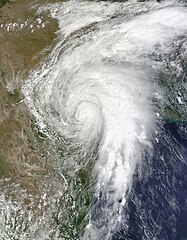Ntxw wrote:Longhornmaniac8 wrote:So this questions goes back a bit to what wxman57 and I were discussing yesterday, but with some new conditions:
Tomorrow, the RAP for the Austin area is showing a very large temperature/dew point spread in the upper/middle atmosphere (which I'm interpreting as unfavorable conditions for precipitation). This is the case all the way until approximately 850 mb, where they suddenly come together (and stay together) all the way to the surface. From the time they come together, they're well below the 0C line, which I thought meant favorable conditions for snow. There is no warm nose present.
What's confusing me is the WWA issued by EWX talks primarily of freezing drizzle/sleet, with snow flurries mentioned only as a possibility. Is there something about the location of the saturation (that is, it's fairly close to the surface...5,000 ft or so) that would inhibit dendritic growth?
I just don't see how the formation of precipitation that falls through a saturated air column below freezing would be conducive to anything other than snow.
Any help here would be much appreciated! We're all trying to learn!
Cheers,
Cameron
Dendritic growth zone, the optimum temperature for them is -10C to -20C. Usually it's higher up in the atmosphere that this occurs (it can happen below but temperatures in your part of the world rarely gets that low near the surface up to 5k ft). You need 100mb+ layer (fairly deep) saturated for the best region to grow these dendrites otherwise the stuff you are seeing is graupel, melted snow, and all that other non uniform stuff, unfinished business.
Ok, so taking that the air column isn't conducive to dendritic growth, I'm still confused what would cause anything to "melt," since the genesis of the precipitation is occurring in a portion of the air column that is below freezing, and falling through air that is below freezing?
Cheers,
Cameron
 The posts in this forum are NOT official forecast and should not be used as such. They are just the opinion of the poster and may or may not be backed by sound meteorological data. They are NOT endorsed by any professional institution or
The posts in this forum are NOT official forecast and should not be used as such. They are just the opinion of the poster and may or may not be backed by sound meteorological data. They are NOT endorsed by any professional institution or 

















